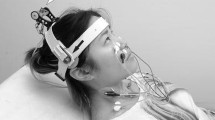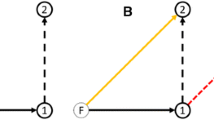Abstract
THE extraocular muscles of most mammals contain stretch receptors which are not necessarily in the form of muscle spindles. The cat, for example, has no muscle spindles, but the oculomotor muscles contain structures, with spiral endings, that are in parallel with the muscle fibres and respond to stretch1. Most proprioceptive fibres run extraorbitally in the ophthalmic branch of the Vth nerve2,3. The cell bodies of these fibres seem to be located in the mesencephalic root of the Vth nerve4. There is electrophysiological evidence of proprioceptive projections to the cerebellum5,6, superior colliculus7,8 and visual cortex9. The function of ocular proprioception is uncertain, although there is evidence that in man it may be an indicator of eye position in the dark10. In the cat it seems to have a role in maintaining the binocularity of single neurones in the visual cortex11,12. Because most proprioceptive fibres run into the ophthalmic branch of the Vth nerve, we have investigated eye movements in the alert animal before and after section of this branch. We report here that, in the absence of visual and vestibular stimuli, the eye ipsilateral to the section becomes unstable and performs slow pendular oscillations. Asymmetries are observed in the horizontal vestibular nystagmus recorded in total darkness from the two eyes after unilateral section.
Similar content being viewed by others
References
Bach-y-Rita, P. & Ito, F. J. Physiol., Lond. 186, 663 (1966).
Batini, C. & Buisseret, P. Arch. ital. Biol. 112, 18 (1974).
Batini, C., Buisseret, P. & Buisseret-Dalmas, C. Brain Res. 85, 74 (1975).
Buisseret, P., Guéritand, J. P., Horcholle-Bossavit, G. & Tyc-Dumont, S. J. Physiol., Paris 65, 369 A (1972).
Fuchs, A. & Kornhuber, H. H. J. Physiol., Lond. 200, 713 (1969).
Baker, R., Precht, W. & Llinás, R. Brain Res. 38, 440 (1972).
Abrahams, V. C. & Rose, P. K. J. Neurophysiol. 38, 10 (1975).
Rose, P. K. & Abrahams, V. C. Brain Res. 97, 95 (1975).
Buisseret, P. & Maffei, L. Expl Brain Res. 28, 421 (1977).
Skavenski, A. A. Vision Res. 12, 221 (1972).
Maffei, L. & Bisti, S. Science 191, 579 (1976).
Maffei, L. & Fiorentini, A. Brain Res. 105, 73 (1976).
Author information
Authors and Affiliations
Rights and permissions
About this article
Cite this article
FIORENTINI, A., MAFFEI, L. Instability of the eye in the dark and proprioception. Nature 269, 330–331 (1977). https://doi.org/10.1038/269330a0
Received:
Accepted:
Published:
Issue Date:
DOI: https://doi.org/10.1038/269330a0
- Springer Nature Limited
This article is cited by
-
Brain control and information transfer
Experimental Brain Research (2015)
-
Palisade endings and proprioception in extraocular muscles: a comparison with skeletal muscles
Biological Cybernetics (2012)
-
A review of the role of efference copy in sensory and oculomotor control systems
Annals of Biomedical Engineering (1995)
-
Short- and long-term effects of transection of the ophthalmic nerve on optokinetic nystagmus in the rabbit
European Archives of Oto-rhino-laryngology (1991)
-
Development of the kitten visual cortex depends on the relationship between the plane of eye movements and visual inputs
Experimental Brain Research (1988)





